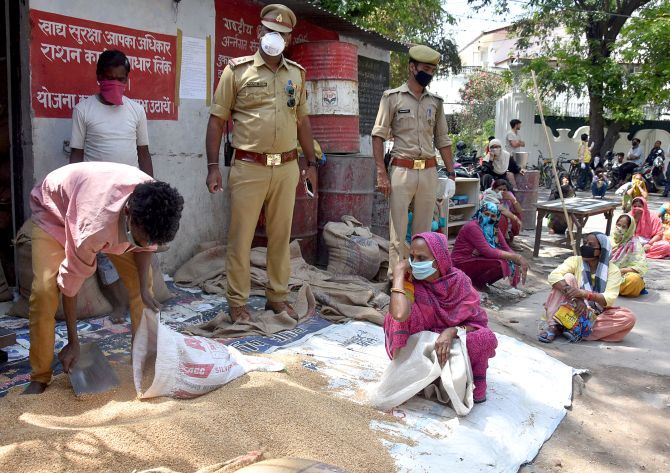In the three months leading up to the assembly elections, Chief Minister Yogi Adityanath’s government distributed over 1.4 million tonnes of wheat, 0.95 MT of rice, 0.10 MT of chana (gram), 101.9 million litres of soybean oil and 100,000 tonnes of salt as free ration. This was part of the Covid relief package, officials said.

Several political commentators have said this could be one of the factors that helped the UP government return to power in the state. The ration was distributed to around 146 million beneficiaries across the state, and is estimated to have cost the exchequer around Rs 300 crore per month, officials said.
It was also distributed to regions where marginalised groups are dominant. For instance, official data shows that in December, the maximum distribution was done in Ambedkar Nagar district to among 389,000 ration card holders, while in January Mirzapur topped the list with free ration for 440,000 card holders.
Ambedkar Nagar again topped the list in February with 390,000 ration card holders benefitting. Sources said both Ambedkar Nagar and Mirzapur are dominated by people from the less privileged caste.
The distribution of soybean oil, salt and chana, was in addition to the free foodgrain distributed through the Public Distribution System under the Centre’s National Food Security Act (NFSA) and also the Pradhan Mantri Gareeb Kalyan Ann Yojana (PMGKAY).
Ration was distributed twice a month, once when just grains were sold and for a second time when the remaining items were distributed.
Besides, state government officials said before the free ration scheme, between April 2018 and February 2022, the state added 12.5 million new beneficiaries to the PDS, while the names of around 950,000 people were deleted for various reasons.
In addition to the special free ration scheme started before the elections, the UP government, along with the Centre, distributed wheat and rice under the PDS and also under the PMGKAY since March 2020.
The government also appears to have increased the efficiency of delivery, with officials saying there was little evidence of mass scale leakages in the distribution, although some beneficiaries complained that they got less than their entitled quota of wheat and rice.
Former food secretary and UP cadre IAS officer Shiraz Hussain told Business Standard that a previous evaluation done by NCAER in 2014 (before the implementation of the National Food Security Act) had found that 33 percent of food grains meant for below poverty line and 35 per cent for above poverty line families had leaked in Uttar Pradesh. There is no recent evaluation of leakage but the tenor of debate in UP shows that leakages might have come down.
Hussain said that in 2019-20, data showed that the state government had lifted almost 96 per cent of the wheat and rice allocated from the central government.
Reports said that in addition to the normal allocation of 8.96 MT under the NFSA, an additional allocation of 5.8 MT was made in 2020-21. This additional allocation under PMGKAY was to be distributed free to ration card holders, unlike the normal allocation under the NFSA.
In 2021-22, UP received 3.238 MT of rice and 4.857 tonnes of wheat under PMGKAY.
An additional allocation of 8.10 MT was made. This was only slightly lesser than the normal allocation of 8.96 MT, sources said. Ration card holders are estimated to have received almost twice the quantity they would have done if no additional allocations were made under PMGKAY.











